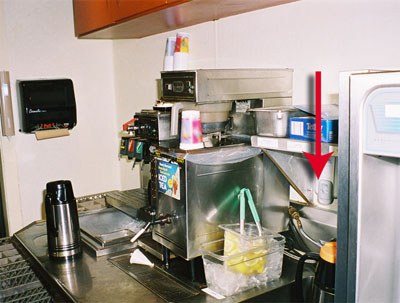This hotel in California, part of a national chain, offers a custom breakfast served from this atrium bar. Working around the beer taps, the busy staff keeps a supply of food nearby – on the handsink, just below the health department’s neatly framed certificate.
“Double Blocked” – a Repeat Offender
This Handsink From Hell, previously labeled as Double Blocked, was originally found in this condition.Obviously it is regularly used as temporary storage, rendering this critical handsink unuseable during many hours of operation. When this restaurant was first designed there may not have been a lock on the adjacent cold storage area. The lock may contribute […]
Distant Drying
Although this handsink is crowded by income producing beverage dispensers, its bigger problem is the location of the paper towels. Wet dripping hands pass over a variety of food contact surfaces including clean glassware.
Find the Handsink #1
Making good drinks is a lot easier than handwashing at this four star Lake Tahoe resort.
Drop Zone
Temporary convenience trumps access to hand soap … all day long.
Kitchens from Hell—A study in what not to do.
This collection is designed as a reminder that good intentions can pave the way to hell’s handsinks. We are confident that acts of maliciousness were not involved in the original installation design and execution. No kitchen designer knowledgeable about food safety would have specified what you are about to see. Some of these hand sinks […]
Setting the Safe Level Standard for Handwashing Frequency
Background: Operators and regulators agree that current foodservice handwashing rates are low, perhaps half of what they should be. Agreement on a Safe Level is far more elusive. Variables in menu, staff training & turnover, process control, physical design/equipment, the vulnerability of the people served and finally the tolerance for risk of the operator himself […]
How does Norovirus take hold?
Norovirus is a very contagious virus that causes vomiting and diarrhea. Anyone can get infected and sick with norovirus. You can get norovirus from: Having direct contact with an infected person Consuming contaminated food or water Touching contaminated surfaces then putting your unwashed hands in your mouth Read More on CDC »




